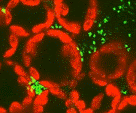Plant Pathology, Department of

Department of Plant Pathology: Faculty Publications
Document Type
Article
Date of this Version
4-23-2018
Citation
2018 The Authors
Abstract
Dollar spot is one of the most destructive and economically important fungal diseases of amenity turfgrasses. The causal agent was first described in 1937 as the ascomycete Sclerotinia homoeocarpa. However, the genus-level taxonomic placement of this fungus has been the subject of an ongoing debate for over 75 y. Existing morphological and rDNA sequence evidence indicates that this organism is more appropriately placed in the family Rutstroemiaceae rather than the Sclerotiniaceae. Here we use DNA sequence data from samples of the dollar spot fungus and other members of the Rutstroemiaceae (e.g. Rutstroemia, Lanzia, Lambertella) collected throughout the world to determine the generic identity of the turfgrass dollar spot pathogen. Phylogenetic evidence from three nucleotide sequence markers (CaM, ITS and Mcm7; 1810-bp) confirmed that S. homoeocarpa is not a species of Sclerotinia; nor is it a member of any known genus in the Rutstroemiaceae. These data support the establishment of a new genus, which we describe here as Clarireedia gen. nov. The type species for the genus, Clarireedia homoeocarpa comb. nov., is described to accommodate the dollar spot fungus, and a neotype is designated. Three new species in this clade, Clarireedia bennettii sp. nov., Clarireedia jacksonii sp. nov., and Clarireedia monteithiana sp. nov. that also cause dollar spot disease are described. Clarireedia homoeocarpa and C. bennettii occur primarily on Festuca rubra (C3 grass) hosts and appear to be restricted to the United Kingdom. Clarireedia jacksonii and C. monteithiana occur on a variety of C3 and C4 grass hosts, respectively, and appear to be globally distributed. This resolved taxonomy puts to rest a major controversy amongst plant pathologists and provides a foundation for better understanding the nature and biology of these destructive pathogens.


Comments
C. Salgado-Salazar et al. / Fungal Biology 122 (2018) 761e773 https://doi.org/10.1016/j.funbio.2018.04.004